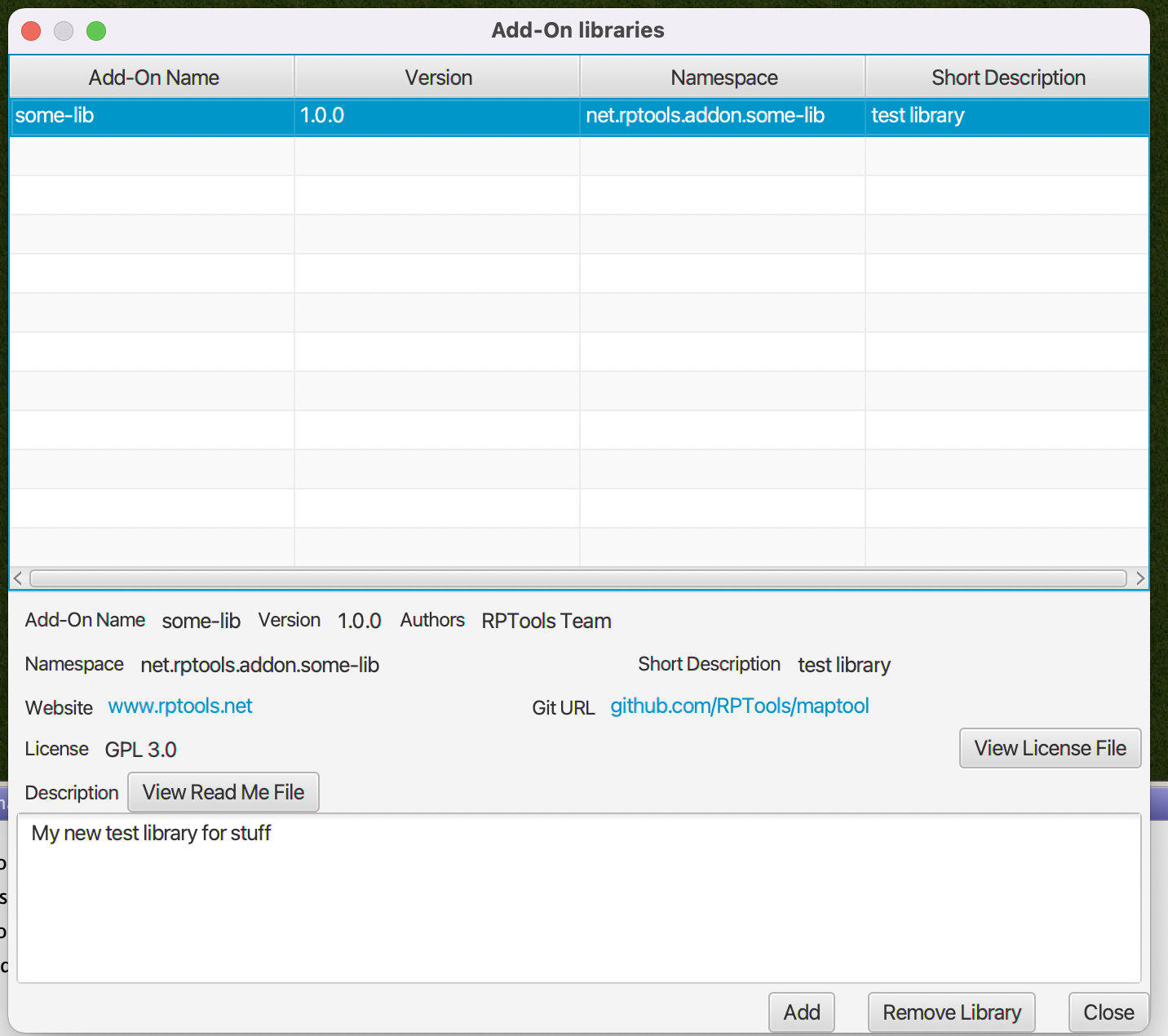Introduction to Add-on libraries: Difference between revisions
m (added categories) |
m (Added note about how setLibProperty() stores persistent data) |
||
| (7 intermediate revisions by 2 users not shown) | |||
| Line 1: | Line 1: | ||
{{ | {{Beginner}} | ||
[[Category:Tutorial]] | [[Category:Tutorial]] | ||
== What Is An Add-on Library? == | == What Is An Add-on Library? == | ||
An Add-on | An Add-on Library is an extension to MapTool that may contain code, images or more. These were introduced in MapTool 1.11, and are intended to be a replacement for [[Library Tokens]] that are easier to work with while offering more functionality. | ||
Add-on libraries are generally distributed as .mtlib files, which are just renamed .zip file with a specific structure. | |||
Add-on Libraries are added to a campaign and are saved as part of the campaign file. | |||
an | When the {{func|setLibProperty}} function is called on an add-on, the property name and value are stored in a campaign area. That area is '''NOT''' cleared when the add-on is removed. This allows the data to persist across add-on updates. (Currently (as of v1.14.3), there are no corresponding functions to clear this data, so the only way to erase it is to create a new campaign.) | ||
== | == Managing the Add-On Libraries for Your Campaign== | ||
[[File:addon-dialog.png|400px|thumb|Add-on Library dialog]]The dialog to manage the add-on libraries for your campaign can be reached using the {{ui location|File > Add On Libraries...}} menu option. | |||
This dialog can be used to add or remove add-on libraries, view the details of all add-ons in the campaign and view their license/read me files. | |||
As of MapTool 1.12, add-on libraries can be dragged and dropped onto the map from your system's file explorer. This will either add the add-on library to the campaign or replace it if it is already in the campaign. | |||
== Things still to be addressed == | |||
*There is only minimal checking of data when importing add-ons so error reporting is not great. | |||
*Expanding the JavaScript API which will make this much more useful (part of another change set). | |||
*Better replacement for user defined functions. | |||
*Providing an equivalent to [[Library Token]]s buttons. | |||
*Ability to check URL for later version and update from that (most likely GitHub to start with) | |||
*Link maps to required add-ons when exporting/importing. | |||
*Documentation / procedures for creating a GitHub release for your add-on. | |||
*The data store could be slightly smarter about large text blocks that remain static and attempt to cache them. | |||
Return to: [[Add-On Library]] | |||
Latest revision as of 01:09, 15 February 2024
BEGINNER
THIS IS A BEGINNER ARTICLE
What Is An Add-on Library?
An Add-on Library is an extension to MapTool that may contain code, images or more. These were introduced in MapTool 1.11, and are intended to be a replacement for Library Tokens that are easier to work with while offering more functionality.
Add-on libraries are generally distributed as .mtlib files, which are just renamed .zip file with a specific structure.
Add-on Libraries are added to a campaign and are saved as part of the campaign file.
When the setLibProperty() function is called on an add-on, the property name and value are stored in a campaign area. That area is NOT cleared when the add-on is removed. This allows the data to persist across add-on updates. (Currently (as of v1.14.3), there are no corresponding functions to clear this data, so the only way to erase it is to create a new campaign.)
Managing the Add-On Libraries for Your Campaign

The dialog to manage the add-on libraries for your campaign can be reached using the File > Add On Libraries... menu option.
This dialog can be used to add or remove add-on libraries, view the details of all add-ons in the campaign and view their license/read me files.
As of MapTool 1.12, add-on libraries can be dragged and dropped onto the map from your system's file explorer. This will either add the add-on library to the campaign or replace it if it is already in the campaign.
Things still to be addressed
- There is only minimal checking of data when importing add-ons so error reporting is not great.
- Expanding the JavaScript API which will make this much more useful (part of another change set).
- Better replacement for user defined functions.
- Providing an equivalent to Library Tokens buttons.
- Ability to check URL for later version and update from that (most likely GitHub to start with)
- Link maps to required add-ons when exporting/importing.
- Documentation / procedures for creating a GitHub release for your add-on.
- The data store could be slightly smarter about large text blocks that remain static and attempt to cache them.
Return to: Add-On Library